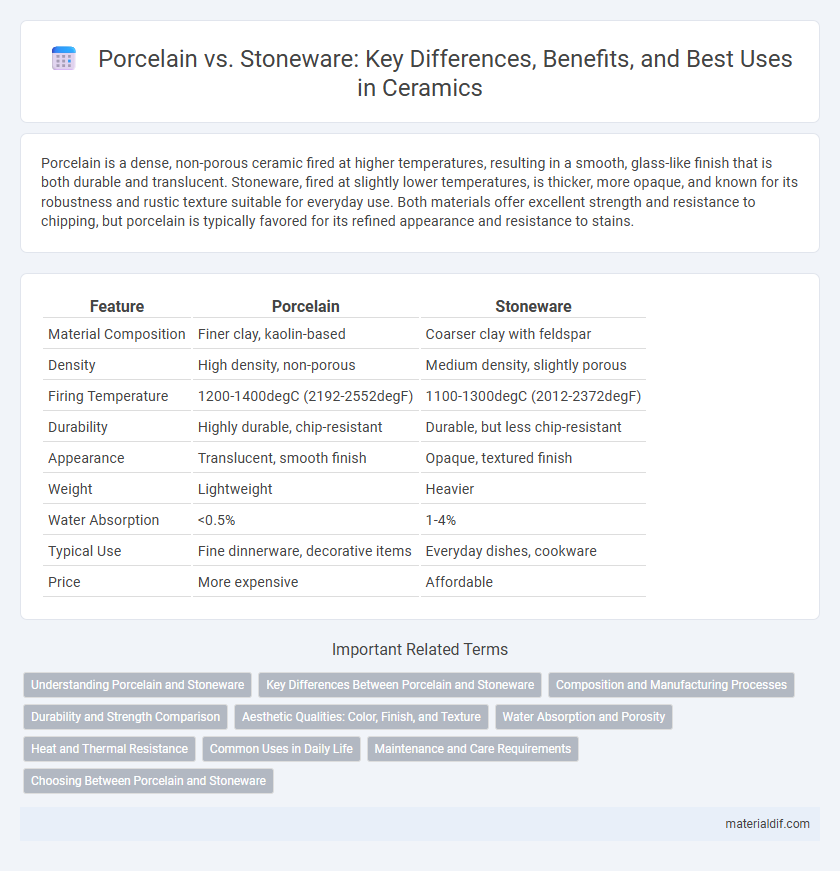Porcelain is a dense, non-porous ceramic fired at higher temperatures, resulting in a smooth, glass-like finish that is both durable and translucent. Stoneware, fired at slightly lower temperatures, is thicker, more opaque, and known for its robustness and rustic texture suitable for everyday use. Both materials offer excellent strength and resistance to chipping, but porcelain is typically favored for its refined appearance and resistance to stains.
Table of Comparison
| Feature | Porcelain | Stoneware |
|---|---|---|
| Material Composition | Finer clay, kaolin-based | Coarser clay with feldspar |
| Density | High density, non-porous | Medium density, slightly porous |
| Firing Temperature | 1200-1400degC (2192-2552degF) | 1100-1300degC (2012-2372degF) |
| Durability | Highly durable, chip-resistant | Durable, but less chip-resistant |
| Appearance | Translucent, smooth finish | Opaque, textured finish |
| Weight | Lightweight | Heavier |
| Water Absorption | <0.5% | 1-4% |
| Typical Use | Fine dinnerware, decorative items | Everyday dishes, cookware |
| Price | More expensive | Affordable |
Understanding Porcelain and Stoneware
Porcelain is a high-fired ceramic known for its translucency, whiteness, and durability, typically fired at temperatures between 1,200 and 1,400 degrees Celsius. Stoneware is also fired at high temperatures, usually between 1,100 and 1,300 degrees Celsius, resulting in a dense, non-porous material that is more opaque and heavier than porcelain. Both materials are favored for their strength and resistance to moisture, but porcelain's finer clay composition and vitrification set it apart in terms of smoothness and delicate appearance.
Key Differences Between Porcelain and Stoneware
Porcelain features a finer, denser composition made from kaolin clay, fired at higher temperatures (around 1,200-1,400degC), resulting in a translucent, non-porous, and highly durable surface. Stoneware is crafted from a coarser clay fired at slightly lower temperatures (about 1,100-1,300degC), producing a more opaque, thicker, and often more rustic texture that is also chip-resistant but less refined than porcelain. The differences in mineral content, firing temperature, and water absorption rates distinguish porcelain's delicate elegance from stoneware's robust, utilitarian practicality.
Composition and Manufacturing Processes
Porcelain is composed primarily of kaolin clay, feldspar, and quartz, fired at higher temperatures ranging from 1200degC to 1400degC, resulting in a dense, glass-like, and translucent body. Stoneware contains a mix of clay and non-refractory materials like ball clay and feldspar, fired at moderate temperatures between 1100degC and 1300degC, producing a durable, non-porous, and more opaque finish. The manufacturing process of porcelain involves precise control over raw material purity and high-temperature firing to achieve vitrification, whereas stoneware involves longer firing cycles and the use of grog or sand for added strength and texture.
Durability and Strength Comparison
Porcelain exhibits higher durability and strength due to its dense, vitrified composition that resists chipping and cracking better than stoneware. Stoneware, while robust and fired at high temperatures, tends to be more porous and slightly less resistant to impact compared to porcelain. Both materials offer strong performance, but porcelain's fine-grained structure provides superior hardness and longevity in tough usage conditions.
Aesthetic Qualities: Color, Finish, and Texture
Porcelain exhibits a smooth, glass-like finish with a generally white or translucent color that allows for delicate, detailed designs, making it ideal for fine tableware and decorative pieces. Stoneware features a more rustic, opaque appearance with earthy tones ranging from browns and grays to deep reds, coupled with a slightly rougher texture that enhances its natural, handcrafted aesthetic. The contrast in finish and texture between porcelain's refined elegance and stoneware's robust, artisanal character defines their unique visual appeal.
Water Absorption and Porosity
Porcelain exhibits significantly lower water absorption rates, typically below 0.5%, due to its dense, vitrified structure, making it highly resistant to moisture and stain penetration. Stoneware, with a higher porosity level, absorbs between 1% and 5% of water, which can affect its durability and suitability for certain applications. This difference in porosity and water absorption influences the choice of material based on the required strength, resistance to liquids, and intended use in ceramics.
Heat and Thermal Resistance
Porcelain exhibits superior heat resistance due to its high firing temperature, typically between 1,200 to 1,400degC, making it less prone to thermal shock and ideal for high-temperature cooking. Stoneware, fired at slightly lower temperatures around 1,100 to 1,300degC, offers good thermal durability but is more susceptible to cracking under rapid temperature changes. The dense, vitrified structure of porcelain ensures enhanced thermal stability compared to the more porous composition of stoneware.
Common Uses in Daily Life
Porcelain is widely used in fine dinnerware, decorative items, and bathroom fixtures due to its strength, translucency, and smooth finish. Stoneware, known for its durability and chip resistance, is commonly found in everyday kitchenware such as mugs, bowls, and baking dishes. Both materials excel in different home applications, with porcelain preferred for elegant settings and stoneware favored for casual, practical use.
Maintenance and Care Requirements
Porcelain requires minimal maintenance due to its non-porous surface, making it highly resistant to stains and easy to clean with mild detergents. Stoneware, while durable, is more porous and often needs sealing to prevent moisture absorption and staining, requiring periodic resealing for optimal protection. Both ceramics benefit from gentle handling and avoiding abrasive cleaners to maintain their finish and longevity.
Choosing Between Porcelain and Stoneware
Porcelain offers a refined, non-porous surface with high durability suitable for fine dining and intricate designs, while stoneware provides a thicker, more rustic appeal with excellent chip resistance and heat retention. Selecting between porcelain and stoneware depends on usage needs: porcelain excels in elegance and resistance to stains, whereas stoneware is ideal for casual, everyday use due to its robust nature. Consider factors such as thermal shock resistance, maintenance requirements, and aesthetic preferences to determine the optimal ceramic choice for your tableware or cookware.
Porcelain vs Stoneware Infographic

 materialdif.com
materialdif.com